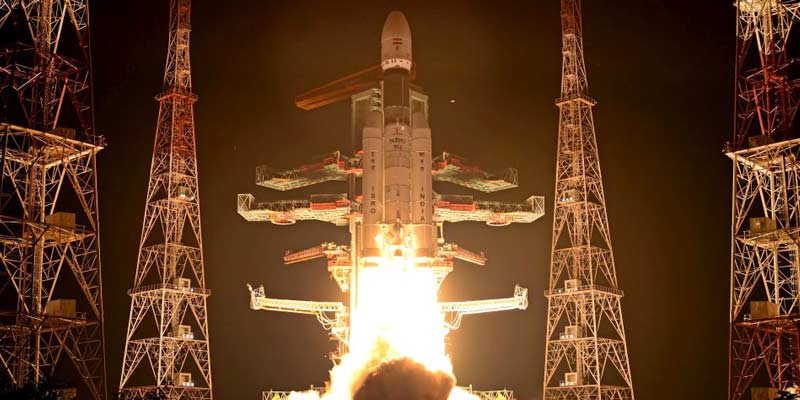- India
- Oct 24
ISRO’s heaviest rocket LVM3-M2 launches 36 OneWeb satellites
Indian Space Research Organisation’s (ISRO) heaviest rocket LVM3-M2 successfully placed 36 broadband communication satellites of OneWeb Ltd into the intended orbits on its maiden commercial mission.
This launch by ISRO and NewSpace India Ltd (NSIL) is one of the biggest commercial orders by India’s premier space organisation, and the first using the LVM3 rocket.
Highlights of the launch
• The 43.5 metre tall rocket soared majestically in the prefixed time from the second launch pad at the Satish Dhawan Space Centre at Sriharikota.
• The vehicle is also dubbed as one of the heaviest for its ability to carry satellites up to 8,000 kg.
• A total of 36 OneWeb Gen-1 satellites of about 150 kg each totaling about 5,796 kg were launched to a circular Low Earth Orbit.
• The launch is also the first for LVM3-M2 to place the satellites in the Low Earth Orbit (LEO-up to 1,200 kms above the Earth) unlike Geosynchronous Transfer Orbit (GTO).
• ISRO scientists had renamed the launch vehicle as LVM3-M2 from GSLV-Mk III as the newest rocket is capable of launching 4,000 kilograms of satellites into GTO and 8,000 kg of payloads into LEO.
• The LVM3-M2 mission would give a fillip to the space agency with the new launch vehicle set to place satellites into the Low Earth Orbit, along with ISRO’s trusted workhorse Polar Satellite Launch Vehicle (PSLV).
• The rocket is a three-stage launch vehicle consisting of two solid propellant S200 strap-ons on its sides and core stage comprising L110 liquid stage and C25 cryogenic stage.
Renaming of GSLV Mark-III
• ISRO has renamed the Geosynchronous Satellite Launch Vehicle (GSLV) Mark-III as Launch Vehicle Mark-III, mainly to identify its task of placing satellites into a variety of orbits.
• The LVM-3 rocket will also be used for India’s maiden human space flight tentatively scheduled for late 2024 and is also emerging as a favourite for ISRO's commercial launches after the successful placing in orbits of 36 OneWeb satellites.
• A GSLV for the GEO orbit will continue to be called so, but the GSLV-Mark III has been renamed as LVM3.
• The LVM3 will go everywhere — GEO (Geosynchronous Earth Orbit), MEO (Medium Earth Orbit), LEO (Low Earth Orbit), missions to the Moon, Sun, etc.
• GSLV Mark-III or LVM3 was used to launch the Chandrayaan-2 mission to the moon in 2019, which was the first operational flight of the rocket.
OneWeb’s 14th launch
• OneWeb is a global communication network powered from space, enabling connectivity for governments, businesses and communities. It is implementing a constellation of Low Earth Orbit satellites. India’s Bharti Enterprises serves as a major investor and shareholder in OneWeb.
• OneWeb Gen-1 satellites utilise a bent-pipe technology approach to offer communication in Ku-band and Ku-bands.
• The satellites are arranged in 12 orbital planes with 49 satellites in each plane at 1,200 km circular orbit.
• OneWeb’s satellites separated successfully from the rocket and were dispensed in nine phases over a period of 1 hour and 15 minutes, with signal acquisition on all 36 satellites confirmed.
• This is OneWeb’s 14th launch, bringing the constellation to 462 satellites.
• The constellation will have a total of 648 satellites.
• This launch represents more than 70 per cent of its planned 648 low Earth orbit (LEO) satellite fleet that will deliver high-speed, low-latency connectivity worldwide.
• With only four more launches to go, OneWeb remains on track to activate global coverage in 2023, while its connectivity solutions are already live in regions north of 50-degrees latitude.
Manorama Yearbook app is now available on Google Play Store and iOS App Store


